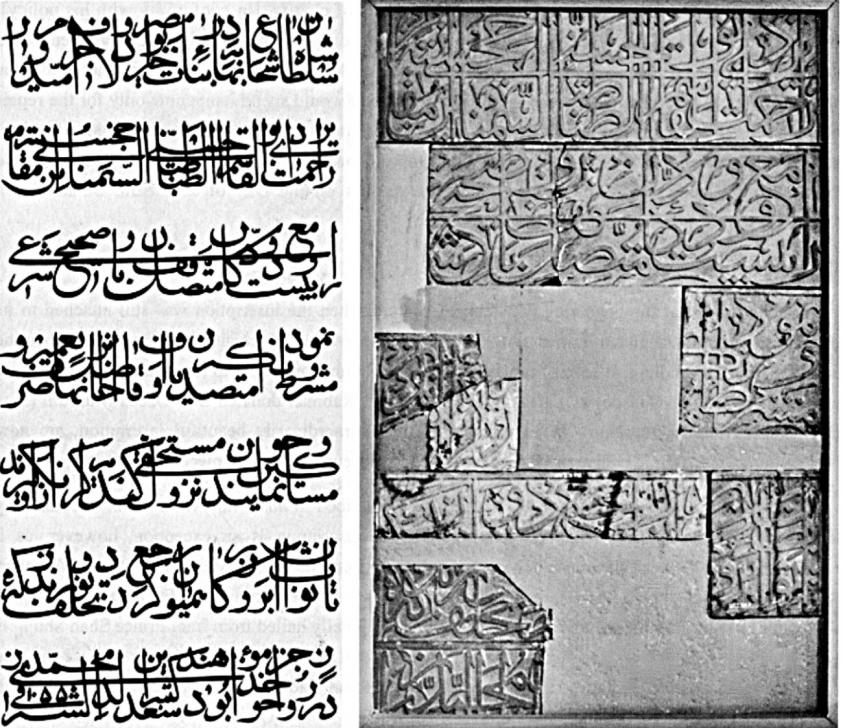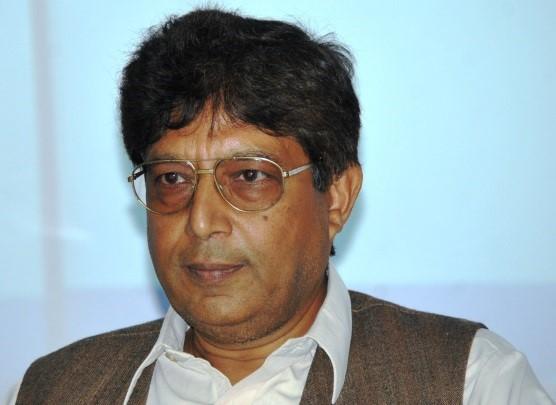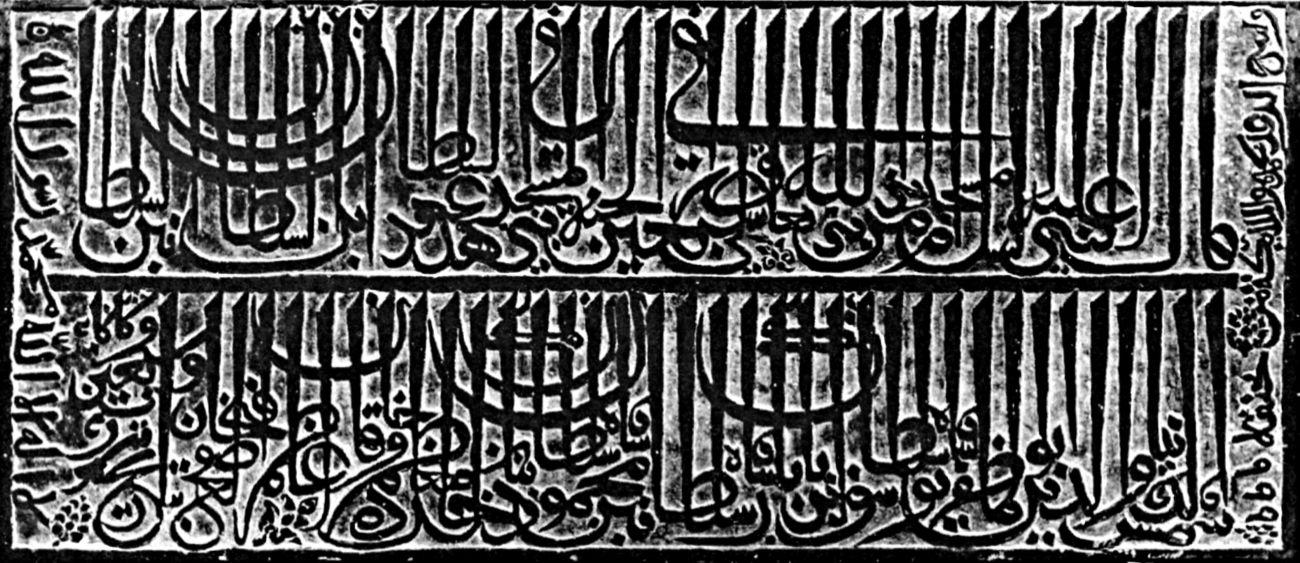SHAMSUDDOZA SAJEN
Did you know that the famous Bara Katra, located in the old quarters of Dhaka city, was built to be an exact replica of the garden of paradise? It is also little known that its patron Mughal Prince Shah Shuja (1616–1661AD) was not satisfied with the structure and thus ordered it to be used as a caravanserai instead. These historical facts can be gleaned from the Persian inscription (pictured below) affixed to the building. Another inscription related to this fabulous structure informs that twenty-two shops were endowed for the regular maintenance of the building and for upkeep of the poor, and that no rent would be charged to those who deserved to stay there for free. This inscription used to be attached to the main gate of the Bara Katra, but is now preserved at the Bangladesh National Museum.

There are hundreds of such inscriptions scattered over the whole of Bengal, including present day Bangladesh and West Bengal, which are living testimonies to the splendour that was Bengal during the Sultanate and Mughal rule. Professor Richard Eaton (author of The Rise of Islam and the Bengal Frontier, 1204–1760 [1993]) rightly opines, “Nowhere was Islamic culture in Bengal expressed more vividly or distinctly than in the region’s rich tradition of public inscriptions, recorded either in Arabic or in Persian.”
Though a number of epigraphic studies of Bengal have been carried out in the past such as Bibliography of the Muslim Inscriptions of Bengal (1957) by Ahmad Hasan Dani and Corpus of the Arabic and Persian Inscriptions of Bengal (1992) by Abdul Karim, the recently published Arabic and Persian Inscriptions of Bengal (2017) by Mohammad Yusuf Siddiq deserves special mention because of its intensive analysis and extensive collection of inscriptions. The author has taken a creative approach in the cultural and historical interpretation and analysis of many freshly discovered inscriptions. Professor Siddiq is a distinguished scholar in the field of Islamic history, particularly Islamic epigraphy. He has held various prestigious academic positions in world-renowned universities such as Harvard, MIT and Oxford.

The book discusses 425 inscriptions with 607 plates dating from Bengal’s Sultanate Period through to the succeeding Mughal period. The earliest inscription is dated 1210-13 AD and the latest is from 1844 AD. These epigraphic records enable readers to understand the transformations in style and subject matter of inscriptions as well as their practical utility with the changes in political administration over the long six-hundred-years of Muslim rule in Bengal.
Bengal already had a rich epigraphic heritage extending back to the pre-Sultanate period. The Muslim rulers introduced various intricate and stylised forms of calligraphy in the inscription style of this area and raised it to a high aesthetic level. Like their Pala and Sena predecessors, Bengal’s Muslim rulers used exquisite black basalt as the preferred medium for recording public inscriptions. But there is a marked difference in execution of inscription work between the earlier (Sanskrit and Proto-Bengali) epigraphs and Islamic (Arabic and Persian) ones. While the former epigraphs are mostly incised, the later ones are in general rendered in relief [Siddiq (2017): 49].

Glorification of Allah is at the heart of calligraphy. Professor Siddiq opines that the written form of Allah in Arabic was a great source of consolation, providing a mental image for contemplating and meditating about God, for the newly converted Muslim of the Bengal who had a strong tradition of religious iconography and symbolism.
Islamic inscriptions vary from region to region in both their artistic expressions and literary styles. But there is a remarkable continuity in the Islamic messages these inscriptions convey, which travelled across the Islamic world. Professor Yusuf Siddiq terms this circulation process as “globalization of the medieval world of Islam”. The extraordinary collection of Islamic inscriptions from Bengal, reproduced in this book, attests to the region’s prominence in this unique global phenomenon.

In the Islamic world, inscriptions can be found not only on buildings, but also on textiles and rugs, metal and glass objects, ceramics and ornaments, not to mention arms, coins and seals. In the second chapter titled “Inscriptions as a source for Islamic history”, Professor Siddiq informs that inscriptions became more common as architectural projects expanded in the Islamic world. Until the eleventh century most inscriptions appeared on the insides of buildings. After that, we see the use of inscription to decorate the outer sides of buildings. It is difficult to imagine a building of the early period without some kind of inscription, as if without one, the building would seem to be incomplete or unfinished, adds the author.
In Bengal, most of the inscriptions appeared on the exterior surfaces of mosques, shrines, tombs, palaces, Sufi hospices and shrines, or on civil structures such as bridges, caravanserais, tanks and wells. The earliest Persian inscription discovered in Bengal was affixed to a bridge near Sultanganj of Chapai Nawabganj. The bridge was built by Sultan Ala Din (1210–13), the second successor of Bakhtiyar Khilji. These secular structures with religious expressions through inscriptions constitute public statements of faith that serve to remind Muslims of aspects of their Islamic belief, explains Professor Siddiq. It also reflects the characteristic Islamic perspective that does not formally separate religious life and everyday worldly activities.

Translation of the inscription
In the beginning, I praise and thank God. The One Who in His (divine) wisdom has provided this inn (like world). At every moment someone is entering into it, while someone else is departing. For no one has the capacity to settle here permanently. As soon as someone becomes aware of the movement of the cosmos, he realises that there is no provision for the life except good deeds. Due to the justice of Sultan Ala Din wa Dunya Shah-e-Jahan, even a lamb does not (need to) hide from a wolf. Because of his efforts, Islam grows every moment. By the mercy of (God) the Just, this bridge was completed during his reign. This good deed was accomplished by the benevolent (sultan), engaged day and night in welfare works for the nobles and the commoners.
A detailed study of popular calligraphic styles in Bengal is presented in the chapter five titled “Inscription as art in Islamic architecture Bengal”. During the Sultanate period (14th to early part of the 16th century) the tughra style flourished and dominated architectural calligraphy of Bengal. The inscription of the tughra type are distinctive for their elongated shafts formed from Arabic letters like alif or lam, which rise to the top of a panel in a symmetrical way. The other letters such as nun or fi sweep across the vertical shafts, appearing rather like swans or boats coursing across the black basalt platform. The author informs that there is a rhythmic pattern in the movement of the letters and the flow of lines in Bengali tughra, which in abstract forms ranging from boats and oars, and swans and reeds, contain a metaphorical expression of riverine Bengal. However, the tughra style lost its popularity to the nastaliq style which was patronised by the Mughals.
The calligraphies in inscriptions not only convey message as text but also constitute a vibrant decorative appeal. In some buildings the calligraphic panels were placed too high to be deciphered, which suggest that their aesthetic impact was more important than their textual message. In many inscriptions, the logic of the pattern of ornamentation took precedence over legibility. Professor Siddiq refers to early kufi inscriptions and some Bengali tughra inscriptions from the Sultanate period that are almost indecipherable but look very attractive in terms of decoration. He adds that this development is inspired by a mystical tendency that not all inscriptions may or should be read by ordinary viewers. A strong belief in the hierarchy of knowledge and spiritual development is embedded in such practices.
The last six chapters of the book (chapters 8–13) chronologically presents the inscriptions along with their picture, original texts and English translation of the texts. These inscriptions provide significant facts surrounding construction of various prominent structures of Bengal and thus help fill many gaps in the history of Muslim rule in Bengal, which otherwise have no other written source. For example, from epigraphic evidence we learn that in the reign of the Mughal emperor Aurangazeb (1658–1707) Shiite migrants settled in Bengal and patronised mosques in the Dhaka region. We can also learn that in the same emperor’s reign, Bengali Hindus patronised civil projects like building bridges.
Another significant example is the Masjid inscription found in the village of Burarchar at Daodkandi in Cumilla dated 1591 AD. It is the first properly dated inscription from the Mughal era in Bengal. This epigraph records the political tension that loomed over Bengal due to the incessant fight for the throne of Bengal between the Mughals and the Baro Bhuiyans led by Isa Khan.
The predominance of Persian as the language of inscription also indicates of the growing influence of the Persian language and culture in Bengal, which was a result of increased overland contact with Iran and Central Asia. This new wave of contacts overshadowed the age-old sea link that was once instrumental in the diffusion of Arab-Islamic culture in the coastal areas of the region.
But besides politics, religion and culture, simple details of life and society of the time are revealed through these inscriptions. For example, three inscriptions of Baba Salih reproduced in the book depicts the life of a traditionally successful rural Muslim landowner of medieval Bengal. All three inscriptions are dated between 1504 and 1506 (during the rule of Sultan Husayn Shah). Baba Salih was a resident of village Azimnagar, which is now located in the Dhaka district. It can be conjectured from the first inscription (masjid inscription of Azimnagar dated 1504) that towards the end of his life Baba Salih built a mosque as an act of piety in his village Azimnagar. The next year, he went to Makkah on a pilgrimage. On his successful return, he assumed the title of Khadim al-Nabi Hajji al-Haramayn wa Zair al-Qadamayn [the servant of the prophet—the one who made a pilgrimage to two most sacred places (Haramayn) and two holy footprints (Qadamayn)]. This information, dated 1505, is recorded in the masjid inscription of Bandar. An inscription in the following year records the death of the pious man. Apparently, this inscription was set on him tomb intended to be a shrine for the locality.
Through such interesting and informative details, Arabic and Persian Inscriptions of Bengal takes the readers in an epigraphic journey into a crucial period of the history of Bengal and helps understand the complex socio-politico-religious transformation process associated with the advent of Muslim rule in this region. This is an invaluable reference book for every researcher and history enthusiast.
Shamsuddoza Sajen is an Archivist at Bangladesh on Record. He is also Commercial Supplements Editor of The Daily Star. Email: [email protected]
